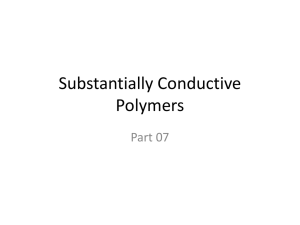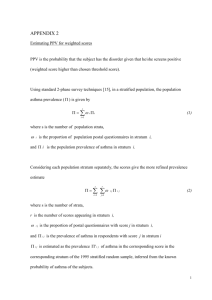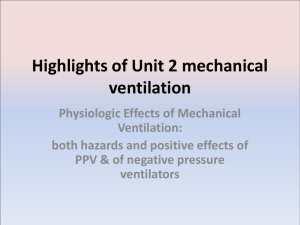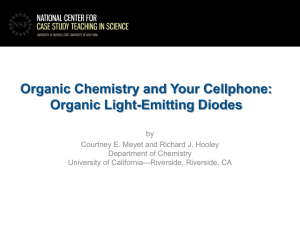file - Genome Biology
advertisement
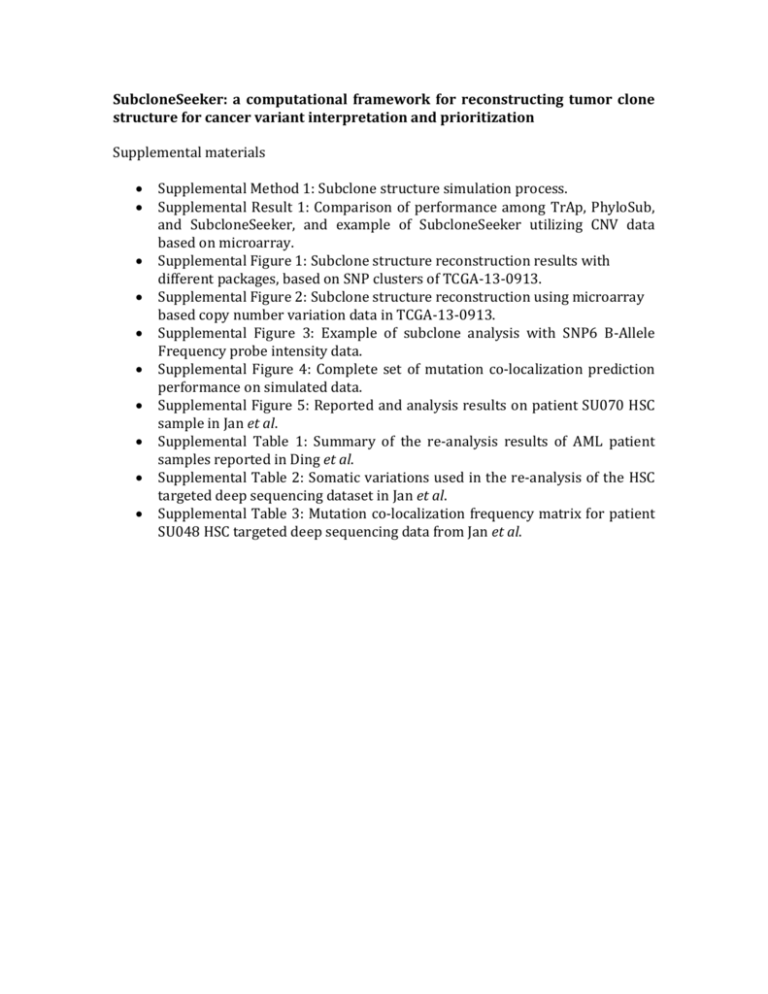
SubcloneSeeker: a computational framework for reconstructing tumor clone
structure for cancer variant interpretation and prioritization
Supplemental materials
Supplemental Method 1: Subclone structure simulation process.
Supplemental Result 1: Comparison of performance among TrAp, PhyloSub,
and SubcloneSeeker, and example of SubcloneSeeker utilizing CNV data
based on microarray.
Supplemental Figure 1: Subclone structure reconstruction results with
different packages, based on SNP clusters of TCGA-13-0913.
Supplemental Figure 2: Subclone structure reconstruction using microarray
based copy number variation data in TCGA-13-0913.
Supplemental Figure 3: Example of subclone analysis with SNP6 B-Allele
Frequency probe intensity data.
Supplemental Figure 4: Complete set of mutation co-localization prediction
performance on simulated data.
Supplemental Figure 5: Reported and analysis results on patient SU070 HSC
sample in Jan et al.
Supplemental Table 1: Summary of the re-analysis results of AML patient
samples reported in Ding et al.
Supplemental Table 2: Somatic variations used in the re-analysis of the HSC
targeted deep sequencing dataset in Jan et al.
Supplemental Table 3: Mutation co-localization frequency matrix for patient
SU048 HSC targeted deep sequencing data from Jan et al.
Supplemental Method 1: Subclone structure simulation process.
In order to understand the behavior of our subclone reconstruction algorithm, we
designed a tumor subclone structure simulator. The simulator initialize in a state
that it only contains one subclone with no somatic event. This ‘null’ subclone
logically represents the normal tissue before tumor expansion, and mathematically
represents the normal tissue contamination usually found in tumor sample. We also
assign a ‘viability’ value of 100 to this null subclone. The viability value represent
the ability for a certain subclone to grow, and will ultimately determine the subclone
frequency (SF) of each subclone. The simulator will now repeat the following steps
exactly n times to simulate one subclone structure with n subclones.
1. From the existing subclones, a ‘parent’ subclone will be selected
randomly by rolling a roulette wheel. The proportion of each subclone on
the roulette wheel is determined by the viability value of the subclone.
2. A new subclone is created, with one additional mutation, and attached as
a children node to the parent subclone. The mutation is only symbolic, so
that allele frequency can be calculated at the end.
3. The viability value of the new subclone is determined by randomly
sampling from a uniform distribution with a range of (0.5 * Parent’s
Viability, 2 * Parent’s Viability), signifying that a mutation can be
beneficial, detrimental, or neutral to the growth advantage.
The process is not meant to accurately model the actual tumor microevolution, but
to create a large number of subclone structures with varying topology and cell
prevalence. After the structure is created, each subclone is assigned a SF
proportional to its viability value:
𝑉𝑖𝑎𝑏𝑖𝑙𝑖𝑡𝑦𝑖
𝑆𝐹𝑖 =
∑ 𝑉𝑖𝑎𝑏𝑖𝑙𝑖𝑡𝑦
The cell prevalence value for each of the introduced mutations will be calculated,
which will serve as the input to the subclone reconstruction algorithm.
1, if subclone 𝑖 contains mutation 𝑗
𝐶𝑃𝑗 = ∑ 𝑆𝐹𝑖 ∙ 𝐵𝑖 ; 𝐵𝑖 = {
0, otherwise
𝑖
The output of the simulation procedure will be a subclone structure, along with the
CP value of all the mutations. The CP values will be used as input to the subclone
reconstruction algorithm, and the subclone structure will be used to check if, among
the results produced by the reconstruction, the correct structure has been found.
Supplemental Result 1: Comparison of performance among TrAp, PhyloSub,
and SubcloneSeeker, and example of SubcloneSeeker utilizing CNV data based
on microarray.
Subclone reconstruction by TrAp [3] and Phylosub [4], using raw 454
sequencing read counts for each SNVs. We first attempted to perform subclone
reconstruction using the raw read counts of 21 validated somatic SNVs with 738x
median and 1018x mean coverage, as this is the format these packages are designed
to take as their input. However, TrAp (v0.3) issued an OutOfMemory error with 4G
memory allocated to the JVM, and PhyloSub (commit 540fdfb003, as of 17 June
2014) produced a partial order plot that made little sense due to the high number of
nodes and edges. See Additional file 3 for the actual dataset used for this test.
Subclone reconstruction by SubcloneSeeker, using SNV clusters. We clustered
the same 21 SNPs on the primary / relapse allele frequency space, and identified
four clusters (Supplemental Figure 1). SubcloneSeeker produced two structures
with the primary clusters and one solution with the relapse clusters. One of the
primary structures was trimmed away during the primary / relapse tree merging,
resulting in a unique subclone structure for this patient.
0.4
C4
Primary Structure(s)
Relapse Structure(s)
Merged Structure(s)
C1
0
,0
.3
7
C3
0
.4
6
,0
.4
0
C1
C1
C1
C1
C2
C1
C3
C4
C1
C1
0.2
0.3
0
.0
7
,0
.3
7
0.1
C1
C2
C1
C3
C2 0.39,0
0.0
Allele Frequency in Relapse Tumor
AF Distribution of SNPs in TCGA-13-0913
0.0
0.1
0.2
0.3
0.4
Allele Frequency in Primary Tumor
0.5
C1
C2
C1
C3
C1
C2
C3
Supplemental Figure 1, Subclone structure reconstruction results with different packages, based on SNP
clusters of TCGA-13-0913. Left: The clusters, as well as their centroid allele frequency values Right: The
primary, relapse, and merged primary / relapse pair structures identified by SubcloneSeeker.
SubcloneSeeker’s unique ability to perform structure reconstruction on
additional data types.
We obtained CNV segments from TCGA-13-0913
microarray level 2 probe intensity data (See Additional file 4 for the raw segmental
data), and clustered them in primary / relapse CP space. The reconstruction result
(Supplemental Figure 2) suggests the same conclusion as presented in the main text
(Figure 6A, Supplemental Figure 1), although the exact structure for the primary
tumor sample differs. This is because that, although these two datasets were from
the same patient, the DNA samples are different preparations, resulting in different
sampling on the underlying tumor cell population, and consequently would not
necessarily correspond to the same subclone structure / fraction distribution, or
that each could be providing a partial view on the overall subclone structure.
C1
C3
C4
A
CP distribution of CNV segments in patient TCGA −13−0913
C
0
.8
0
.6
20%
19%
0
.8
7
,0
.7
2
0
.7
1
,0
.5
8
C1
C1
C1
0
,0
.5
8
C1, C2
0
.4
C4
80%
4%
C2
C1, C2,
C4
77%
0
.2
C
e
llP
r
e
v
a
le
n
c
e
o
fC
N
V
s
e
g
m
e
n
ts
in
r
e
la
p
s
e
1
.0
B
C1, C2,
C3
0
.0
0
.6
7
,0
C3
C
N
V
n
e
u
tr
a
l
0
.0
0
.2
0
.4
0
.6
0
.8
1
.0
C
e
llP
r
e
v
a
le
n
c
e
o
fC
N
V
s
e
g
m
e
n
ts
in
p
rim
a
r
y
Supplemental Figure 2, Subclone structure reconstruction using microarray based Copy Number
Variation data in TCGA-13-0913. (A) Probe Intensity of both the primary (TCGA-13-0913-01A) and relapse
(TCGA-13-0913-02A) tumor sample. (B) CNV segments clustered on the primary / relapse cell prevalence space.
(C) Subclone structure and relapse pattern from the identified clusters.
A
D
B
E
C
F
G
Normal: 8%
+C1
C1: 26%
Normal: 31%
+C1
C1: 3%
C1: 26%
+C2
+C2
C1, C2: 43%
+C1
+C3
C3: 23%
C1, C2: 43%
Normal: 31%
+C3
C1, C3: 23%
+C2
C1, C2: 20%
+C3
C1, C2, C3: 23%
Supplemental Figure 3, Example of subclone analysis with SNP6 B-Allele Frequency probe intensity data. (A) The B-Allele
frequency (BAF) data in JPII-32 tumor sample is filtered to only retain those that are heterozygous in the JPII-32 normal sample.
(B) The mirrored BAF (mBAF) data is acquired by mapping all BAF data points smaller than 0.5 (denoted as x) to 1-x. (C) mBAF is
then subjected to circular binary segmentation so that continuous segments of LOH can be identified. (D) The copy number probe
Log 2 Ratio track of the SNP 6 array is shown to illustrate that there is no observable copy number alteration that is correlating
with the observed LOH pattern, indicating that the multi-level LOH is a result of multi-clonality. (E) The segmented mBAF values
are converted to cell pravelence value (CP). CP represents, for any given LOH event, what is the fraction of cells that are harboring
the event, out of the entire cell population measured. (F) CP value clusters. (G) Biologically meaningful subclone structures that are
consistent with the CP values. (A) – (E) was originally published in Nature [2]
C.SI
C.PPV
NC.SI NC.PPV
SI
PPV
AMB
0.8
0.0
0.2
0.4
0.6
0.8
0.6
0.4
0.2
0.0
0.0
0.2
0.4
0.6
0.8
1.0
7 Subclones; Thr=0.9
1.0
6 Subclones; Thr=0.9
1.0
5 Subclones; Thr=0.9
C.SI
C.PPV
SI
PPV
AMB
NC.SI NC.PPV
SI
PPV
AMB
AMB
PPV
AMB
1.0
0.6
0.4
PPV
AMB
C.SI
C.PPV
NC.SI NC.PPV
SI
1.0
0.6
0.0
0.2
0.4
0.6
0.8
1.0
7 Subclones; Thr=0.5
0.4
AMB
AMB
0.2
SI
0.2
PPV
SI
0.0
NC.SI NC.PPV
0.0
SI
NC.SI NC.PPV
0.8
1.0
C.PPV
0.8
1.0
0.8
0.6
0.4
0.2
NC.SI NC.PPV
C.PPV
6 Subclones; Thr=0.5
0.0
C.PPV
C.SI
7 Subclones; Thr=0.6
0.6
C.SI
5 Subclones; Thr=0.5
C.SI
PPV
1.0
AMB
0.4
AMB
AMB
0.6
PPV
0.2
PPV
PPV
0.4
SI
0.0
SI
SI
0.2
NC.SI NC.PPV
0.8
1.0
0.8
0.6
0.4
0.2
NC.SI NC.PPV
NC.SI NC.PPV
0.0
C.PPV
6 Subclones; Thr=0.6
0.0
C.PPV
C.PPV
0.8
1.0
0.6
C.SI
5 Subclones; Thr=0.6
C.SI
C.SI
7 Subclones; Thr=0.7
0.4
AMB
AMB
1.0
PPV
0.2
PPV
PPV
0.6
SI
0.0
SI
AMB
0.4
NC.SI NC.PPV
0.8
1.0
0.8
0.6
0.4
0.2
NC.SI NC.PPV
PPV
0.2
C.PPV
6 Subclones; Thr=0.7
0.0
C.PPV
SI
0.0
C.SI
5 Subclones; Thr=0.7
C.SI
NC.SI NC.PPV
0.8
1.0
0.8
0.4
0.2
0.0
C.PPV
C.PPV
7 Subclones; Thr=0.8
0.6
0.8
0.6
0.4
0.2
0.0
C.SI
C.SI
6 Subclones; Thr=0.8
1.0
5 Subclones; Thr=0.8
NC.SI NC.PPV
C.SI
C.PPV
NC.SI NC.PPV
SI
PPV
AMB
C.SI
C.PPV
NC.SI NC.PPV
SI
Supplemental Figure 4. Complete set of mutation co-localization prediction performance on simulated
data. C.SI - Sensitivity for co-localizing cells; C.PPV - Positive predictive value for co-localizing cells; NC.SI Sensitivity for not co-localizing cells; NC.PPV - Positive predictive value for not co-localizing cells; SI - Combined
sensitivity; PPV - Combined positive predictive value; AMB - Ambiguous cell fraction.
Supplemental Figure 5. Reported and analysis results on patient SU070 HSC sample in Jan et al. [1]
(A) Colony assay results reported in Jan et al. (B) Evolution model reported in Jan et al. based on the colony
assay results. (C) The unique evolution tree constructed from the deep sequencing results on heterogeneous
HSC sample.
SU070 (Figure 10) HSC targeted deep sequencing data resulted in a unique solution
(Figure 10C), because of the relatively high AF of the profiled mutations. This
unique solution precisely supports the linear mutation acquisition model reported
in Jan et al. (Figure 10A and B). In the colony assay, two colonies were identified to
have TET2-Y1649STOP, but not TET2-T1884A, whereas in our result, these two
mutations first appeared in the same subclone. Moreover, the AF data from bulk
HSC deep sequencing suggests that TET2-T1884A (AF=48.10%) came before TET2Y1649STOP (AF=47.87%) with only a very small difference in AF. This discrepancy
is likely caused by AF inaccuracies from experimental error. Overall, our result
successfully remodeled the linear mutation acquisition structure, and confirmed the
conclusion that all these mutations in tandem were required for the AML
tumorigenesis.
Patient no.
933124
758168
400220
426980
452198
573988
804168
869586
Solutions based Solutions based Compatible
Whether
the
on
primary on
relapse primary
/ results are in
sample (n)
sample (n)
relapse pairs (n) agreement with
the
model
presented in the
original paper
6
1
1
Yes
1
2
2
No
1
1
1
Yes
1
1
1
Yes
1
1
1
Yes
1
1
1
Yes
1
1
1
Yes
2
1
1
Yes
Supplemental Table 1. Summary of the re-analysis results of AML patient samples reported in Ding et al.
[5].
Patient
Mutation
SU008
SU008
SU008
SU008
SU030
SU030
SU048
SU048
SU048
SU048
SU048
SU048
SU048
SU048
SU070
SU070
SU070
SU070
SU070
SU070
SU070
SU070
SU070
SU070
SU070
SU070
SU070
SKP2
ELP2
PDZD3
CNDP1
KCTD4
SLC12A1
ACSM1
NPM1
OLFM2
PYHIN1
SMC1A
TET2-D1384V
TET2-E1357STOP
ZMYM3
TET2-Y1649STOP
CXOFF36
CACNA1H
TET2-T1884A
CXOFF66
SCN4B
NCRNA00200
GABARAPL1
DOCK9
CTCF
PXDN
TMEM20
TMEM8B
Variant
allele
read count
45,937
1,915
161
2,238
116,061
7,754
16,819
30
13,717
16
181,167
1,797
7,416
18,518
7,732
3,503
12,083
4,218
3,678
5,086
9,199
1,648
3,382
10,529
78
157
69
Reference allele read Variant AF
count
624,754
0.068492048
504,335
0.003782716
100,433
0.001600493
475,621
0.00468339
2,090,267
0.052603693
1,163,598
0.006619701
110,087
0.132531165
11,079
0.002700513
108,695
0.112056008
12,952
0.001233806
477,095
0.275220201
15,854
0.101807263
12,117
0.379665182
288,810
0.060254842
8,419
0.478731967
4,537
0.435696517
12,775
0.48608094
4,552
0.480957811
4,466
0.451620825
11,273
0.310899199
16,212
0.362008579
3,344
0.330128205
5,285
0.390215761
19,561
0.349916916
4,712
0.016283925
14,986
0.010367827
7,791
0.008778626
Supplemental Table 2. Somatic variations used in the re-analysis of the HSC targeted deep sequencing
dataset in Jan et al. [1].
Mutation co-localization frequency matrix
TET2E1357STOP
SMC1A
ACSM1
OLFM2
SMC1A
1
ACSM1
1
1
OLFM2
0.67
0.67
0.33
TET2D1384V
0.75
0.5
0.25
0.25
ZMYM3
0.75
0.5
0.25
0.25
TET2D1384V
0.25
Supplemental Table 3. Mutation co-localization frequency matrix for patient SU048 HSC targeted deep
sequencing data from Jan et al. [1]. Mutations are sorted in descending order by AF.
References
1.
2.
3.
4.
5.
Jan M, Snyder TM, Corces-Zimmerman MR, Vyas P, Weissman IL, Quake SR,
Majeti R: Clonal evolution of preleukemic hematopoietic stem cells
precedes human acute myeloid leukemia. Sci Transl Med 2012,
4:149ra118.
Wang L, Yamaguchi S, Burstein MD, Terashima K, Chang K, Ng HK, Nakamura
H, He Z, Doddapaneni H, Lewis L, Wang M, Suzuki T, Nishikawa R, Natsume A,
Terasaka S, Dauser R, Whitehead W, Adekunle A, Sun J, Qiao Y, Marth G,
Muzny DM, Gibbs RA, Leal SM, Wheeler DA, Lau CC: Novel somatic and
germline mutations in intracranial germ cell tumours. Nature 2014,
511:241-245.
Strino F, Parisi F, Micsinai M, Kluger Y: TrAp: a tree approach for
fingerprinting subclonal tumor composition. Nucleic Acids Res 2013,
41:e165.
Jiao W, Vembu S, Deshwar AG, Stein L, Morris Q: Inferring clonal evolution
of tumors from single nucleotide somatic mutations. BMC Bioinformatics
2014, 15:35.
Ding L, Ley TJ, Larson DE, Miller CA, Koboldt DC, Welch JS, Ritchey JK, Young
MA, Lamprecht T, McLellan MD, McMichael JF, Wallis JW, Lu C, Shen D, Harris
CC, Dooling DJ, Fulton RS, Fulton LL, Chen K, Schmidt H, Kalicki-Veizer J,
Magrini VJ, Cook L, McGrath SD, Vickery TL, Wendl MC, Heath S, Watson MA,
Link DC, Tomasson MH, et al: Clonal evolution in relapsed acute myeloid
leukaemia revealed by whole-genome sequencing. Nature 2012,
481:506-510.


